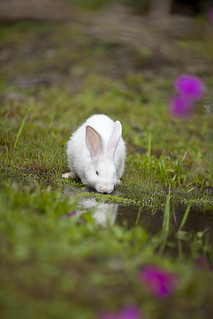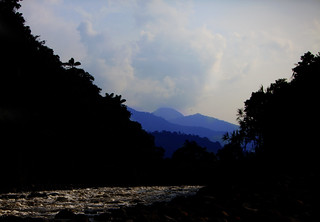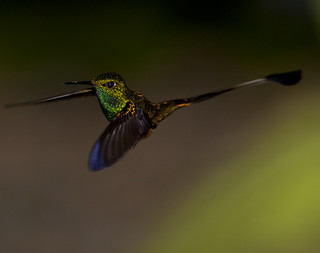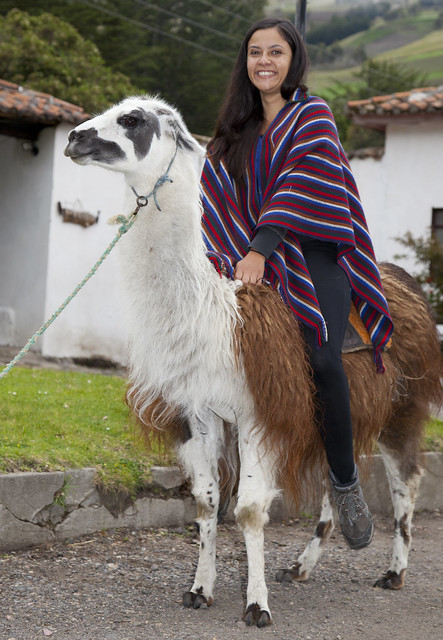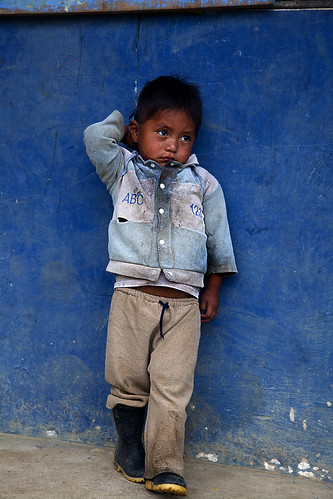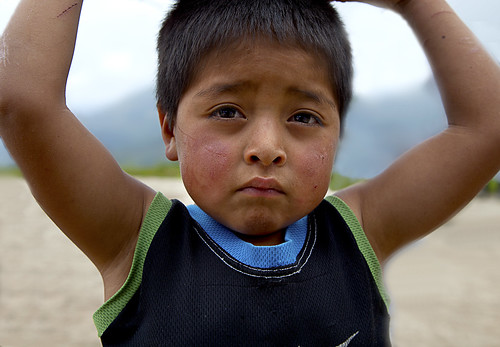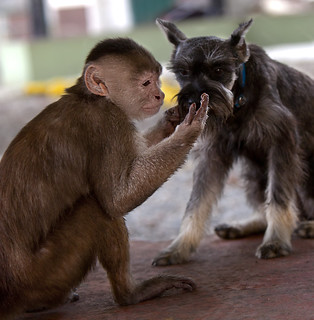Ecuador is a stunning country for a photographer. The landscapes are breathtaking, the wildlife is diverse, and the people are colourful and fun.
 |
| Lake Quilotoa, the volcanic lake with sparkling water |
 |
| Diablo mask in Pillaro |
I spend my life taking photos - sometimes professionally, sometimes just to scratch the itch of addiction. The prospect of moving from England (and recently Belgium) to Ecuador - the land of sun - was exciting. I'm forever chasing light, and light is usually a lot quicker than I am.
 |
| A lily in the morning sun |
MAGIC HOUR
In England the sun might show its face for a few hours a day (if you're lucky) and when it does it's rarely at the perfect time. In the Andean highlands the sun is much more consistent. I am guaranteed at least five hours a day, even on a comparatively overcast day. Also, I get three or four sunny mornings a week - that means sunshine at 7am. Afternoons are more likely to become overcast, but I will still get one or two clear afternoons a week.
You'll notice I obsess about sunny mornings and sunny afternoons - otherwise known as the "magic hour". This is when the low sun allows colours to appear at their richest and shadows stretch long and low across the frame. Sometimes it's impossible to take a bad photo when the light is so perfect... of course, plenty of ham-fisted snappers could prove me wrong.
Living on the equator the magic hour is more critical than ever, but a lot more reliable. There is precisely 12 hours of sun everyday in Quito. It rises at 6am and it sets at 6pm... you can set your watch by it.... or your sundial. Unlike winters in Northern Europe, where the sun appears for a few bare hours and barely pops its cool head low above the horizon, the sun in Ecuador reaches the highest point in the sky all year round. Of course the low winter sun in Europe can produce some beautiful images... just don't hold your breath waiting for it.
 |
| The depth and power of magic hour |
The sun rises at 6am and offers the best light at 7am. By 9am it is rising so quickly you can almost see the shadows shrinking away before your eyes. If you're a landscape photographer your camera will almost certainly be back in the bag by now. At 10am the light is becoming very extreme and will bleach and burn your images.
ONLY MAD DOGS AND ENGLISHMEN GO OUT IN THE MIDDAY SUN
From 11am to 1pm the sun is at its apex and unless your subject is levitating there will be no shadow beneath their feet. It is so extreme that street photography becomes impossible. Faces are shadowed and the streets, exposed under the sun's full glare, become a snowy white (like a Lowry painting).
 |
| The midday sun in Ecuador will bleach your ground white if you want to perfectly expose your subjects... like this painting by LS Lowry |
 |
| Ecuadorians do everything they can to avoid the glare of the midday sun... not good for a photographer |
Unsurprisingly most Ecuadorians wear large rimmed hats to escape the midday sun. Good for preventing melanomas but disastrous for photography. It's impossible to correctly expose these midday photos.
Faces become black impenetrable shadow. However, if you can encourage the subject to tilt their heads to face the sun, just ever so slightly, the difference is remarkable. Compare the effect in the two photos below of an Ecuadorian army parade, taken seconds apart.
 |
| I highlighted his eyes in Photoshop, the shadow is severe |
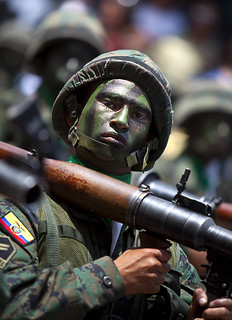 |
| This soldier tilts his head to the sun |
The sunlight conundrum is made all the more difficult because most fiestas in Ecuador get underway at about 11am. On several occasions I've been sat in position, camera in hand, at 9am waiting for the fiesta to begin at its advertised time. So very English am I. Instead I have to watch sorrowfully as the sun ascends and my best laid schemes gang aft agley.
I recently shot an outdoor wedding in Quito under a burning midday sun. It was one of the hardest shoots I've ever done. To make things even more difficult the guests sat outside and the vows were exchanged in a shadow-casting pagoda. Luckily the wedding shoot was a success, thanks to one tool in my little arsenal. The flash.
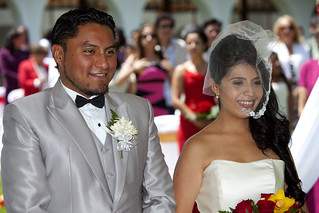 |
| Without a flash this photo would have been impossible, the bride and groom are in shadow but the guests in the background are sat under the midday sun. You need a powerful flash to resolve this dilemma |
PUBLIC FLASHING
If you want to take photos in Ecuador an off-camera flash in essential. I only speak Canon, so a 430EX is the minimum requirement, but two (or more) will make life easier still. Naturally a powerful flash is daunting for subjects if you're shooting street photography. You will lose any element of surprise after the first frame. Subjects instantly turn towards the blinding light that's just fried their corneas. As a result, many of my street/fiesta photos have the subject looking straight down the lens - because my preferred frame was the second or third.
STREET PORTRAIT PHOTOGRAPHY
There's another interesting thing about shooting street photography in Ecuador, compared to Europe. Europeans will become suddenly very shy when the spot a camera and turn their heads away. In Ecuador the people tend to freeze, as though the camera was a loaded gun, and stare directly down the lens. The phenomenon is even more marked when shooting children. I was on an assignment in a remote jungle province and the children in the community would stand for several minutes looking directly down the barrel. They don't speak, they don't smile, they don't blink, instead they return a patient, faraway gaze until you tell them you've finished. Of course, they're desperate to see their photos on the LCD screen afterwards.
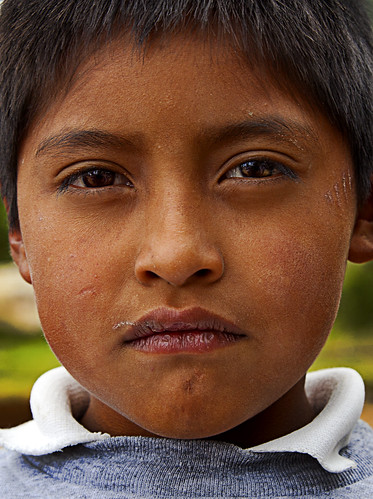 |
| Eyes fixed down the lens - he stood like a statue |
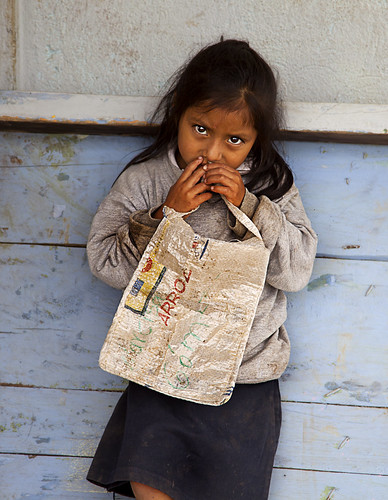
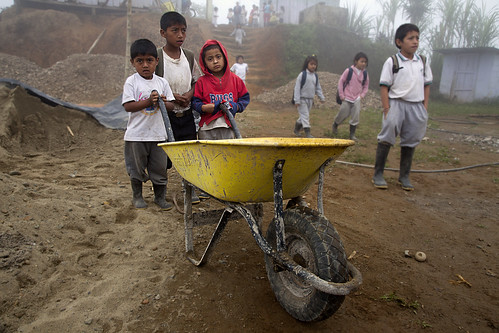 |
| The children wait patiently while you shoot |
MOUNTAINS CAST SHADOWS, DUH!
Perhaps a rather obvious problem with shooting in the Andes is you are surrounded by mountains. Before planning any crack of dawn photo shoots it's always worth scouting the location first. I wanted a panoramic photograph of Quito at dawn from a viewpoint (or mirador) I'd found the week before. I was so excited by the location I hadn't considered the presence of the towering mountain nearby. I arrived bleary-eyed at 6am, but it was 7am before the sun had finally crested the summit behind me. Sunsets are equally problematic for the same reason.
Quito lies north to south, so in theory the evening sun should cast some gorgeous shadows across its most famous landmarks. Unfortunately Quito also sits under the base of the enormous Pichincha volcano (in the west). The evening sun sinks behind Pichincha before the most spectacular effects can be cast over the city. However, from 4:30pm to 5pm there are some stunning scenes to be had.
 |
| Reflections over Pichincha in the morning light |
 |
| This is an example of how quickly Quito loses the evening light. The volcano Cotopaxi (in the centre) is still catching the evening sun but the city of Quito is silhouetted in shadow in the foreground. It can be very frustrating when the sky is as beautiful as this |
SHOOTING IN QUITO
There are five other great miradors I've found in Quito, here are their locations on Google maps:
1)
Cima de La Libertad y Museo Templo de la Patria - this afternoon viewpoint commemorates the battle of liberty against Spanish oppression on the banks of Pichincha.
2)
Guapolo - the artists quarter is a part of the city for street photography. It has some cool bars and coffee shops, cobbled-streets and stunning views out across the valleys.
3)
Parque Itchimbia - I took my first photo-stitch panorama of Quito from here and even though the light was poor, the location is ideal.
 |
| Photo-stitch panorama of Quito from Parque Itchimbia |
4)
Parque Metropolitano - a modern urban park with plenty of clearly sign-posted viewpoints. In the summer heat its a tinderbox for forest fires.
5)
El Panecillo - perhaps the statue of the Virgin, which dominates central Quito, is the most obvious mirador and the most instantly recognisable. However, be careful if you're walking here with your camera gear, the steps up are notorious for robberies so always take a taxi. It's perfectly safe at the summit.
ON THE COAST
The Pacific coast will give consistent light (except for November when it's largely overcast). Most evenings on the coast you're treated to blood red suns bleeding into the western ocean. I foolishly only packed a 100mm lens for the trip, so my sunsets were spoiled. I needed (at a minimum) my 200mm lens, but 300-400mm would have been preferable. All these figures are for a full-frame 5D camera; so crop sensor users should apply the x1.6 factor.
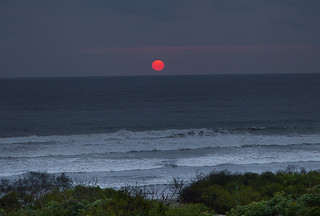 |
| Sunset over the Pacific. Taken at 105mm... I needed 300-400mm lens to make this short work |
SUB-TROPICAL
The sub-tropical area of Ecuador is a treat to shoot. The sun is less consistent than the coast but moody mists sweep across the cloud forests; the rich green trees are packed with brightly coloured, exotic fruits, the earth is a deep red colour and the people are equally colourful and will always oblige for a photo if you're polite and respectful. I took a series of photos of children at rural schools in the jungles here... not to mention the
illegal trago distillery I stumbled across.
THE AMAZON
The Amazon region in theory should be one of the most enjoyable. The wildlife is rich, the lazy rivers are a joy and the there's a certain magic in the very name "Amazonic rainforest" that adds an extra five per cent to any photos you take. However, I've never really had much success here. The weather is generally overcast, the rains are heavier than a power shower and can wreck camera gear, the humidity and the heat is unpleasant and the famished mosquitoes will make long waits in the forest gloom deeply unpleasant. However, just because I've been unlucky so far hasn't dissuaded me of its potential. The sunsets over the river Napo are legendary and I hope to return to this remote region for a second crack.
 |
| The light was so flat (bad) when I was in the Amazon that I had to resort to shooting at night |
HUMMINGBIRDS
Lots of people come to Ecuador to photograph the birds. It's a twitcher's paradise and even though I know nothing about birds, I couldn't resist shooting the hummingbirds. There are over 130 different species of hummingbird in Ecuador and they are beautiful. You hear the hum of their wings and, before you know it, they've whizzed past your ear like a bullet. The time to catch them is when they're sucking nectar from a flower. I spent three days by a banana flower in Vilcabamba with my flash rigged, my camera hidden and my breath held... mostly to no avail. The birds were too suspicious of me. I took the photo below at a hummingbird reserve at Mashpi Lodge where the birds are fed sugary nectar and have no fear of humans. On this occasion I didn't have my flash so had to up the ISO to 1600. To freeze a hummingbird's wing requires a shutter speed no slower than 1/2500... but preferably faster. This is why the flash is so important.
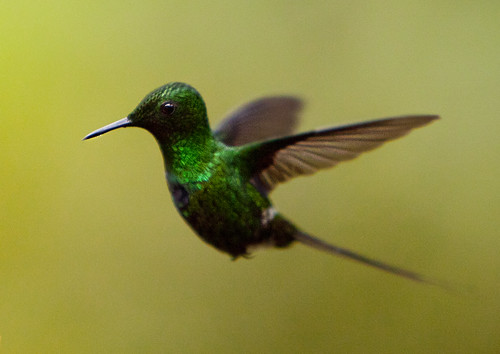 |
| Hummingbirds are a joy to shoot, but tricky too |
SURPRISE, SURPRISE
There always seems to be a surprise waiting around every corner in Ecuador... much more so than in Europe. Perhaps it's just because the country is still relatively new for me? However, I can't leave the house without my camera and at least two different lenses. If I hadn't had my camera ready then I would have missed these three photographs.
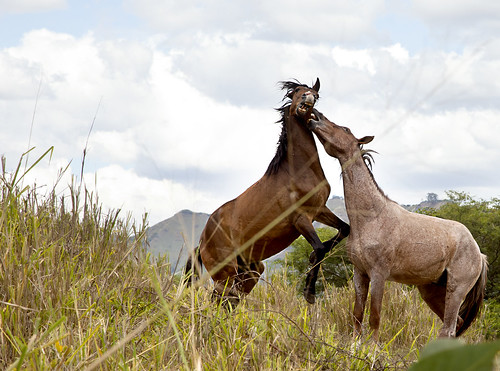 |
| Horses fighting in Vilcabamba |
 |
| Ecuadorian health and safety at fiestas |
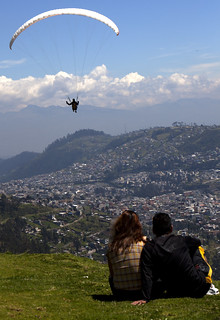 |
| Leaping off the side of a mountain in Quito |
SHOOT RAW, SHOOT RAW, SHOOT RAW
Shooting RAW has saved me innumerable times in Ecuador - even more so than in Europe, where I'm more used to the tricks of the light. If your camera can shoot RAW, then do so. I have saved so many photos from an instant delete with the hidden information contained within a RAW image. There's just so much more flexibility and the ability to balance the light levels in a scene by several exposure shots is an absolute necessity.










